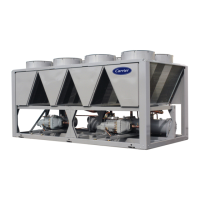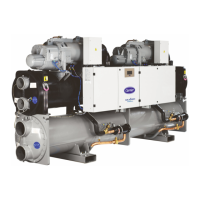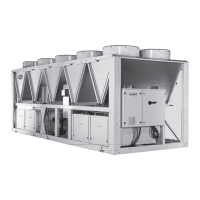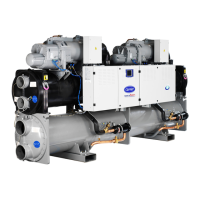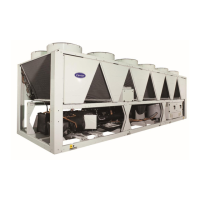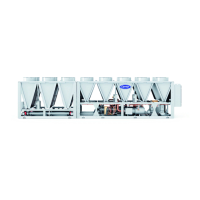DUAL PUMPCONTROLFOR SERIESCHILLER
APPLICATIONS--If pumpcontrolis required, the chiller
pump needs to be controlled by the master chiller only. The
control of the slave chiller is directed through commands
emitted by the master chillel: The slave chiller has no action in
master/slave operations; it shall only verify that CCN commu-
nication with its master is present. See the Dual Chiller
Sequence of Operation section on page 49.
Use dual chiller control to designate a lead chiller between
the master and slave chillel: Configure the Lead/Lag Baltmce
Select (Configuration _RSET---)LLBL) to ENBL to base the
selection on the Lead/Lag Balance Delta (Configuration
_RSET--+LLBD) between the master and slave mn hours. If
the run hour difference between the master and the slave
remains less than LLBD, the chiller designated as the lead will
remain the lead chillel: The Lead/Lag changeover between the
master and the slave chiller due to hour balance will occur dur-
ing chiller operating odd days, such as day 1, &_y 3, and &ty 5
of the month, at 12:00 a.m. If a lead chiller is not designated,
the master chiller will always be designated the lead chiller
The dual chiller control algorithm has the ability to be con-
figured for series or parallel operation. To configure chillers in
series, set Configuration--_RSET---_S'ERI to YES for series
operation, or NO for parallel operation. Both the master and
slave chiller must be configmed the same.
The dual chiller control algorithm has the ability to delay
the start of the lag chiller in two ways. The Lead Pulldown
Time (Configuration---)RSET---)LPUL) provides a field con-
figurable time delay of 0 to 60 minutes. This time delay gives
the lead chiller a chance to remove the heat that the chilled wa-
ter loop picked up while being inactive during an unoccupied
period. The Lead Pulldown Time pmameter is a one-time time
delay initiated after starting the lead chillel: manually or by a
schedule, before checking whether to st_ul an additional chillel:
This routine provides the lead chiller an opportunity to pull
down the loop temperature before starting another chillel: The
second time delay. Lead/Lag Delay (Configuratiml _RSET
--+LLDY) is a time delay imposed between the last stage of the
lead chiller and the start of the lag chillel: This prevents
enabling the lag chiller until the lead/lag delay timer has
expired. See Tables 12 and 13.
Capacity Control- The control system cycles com-
pressors and positions the slide valve of each compressor to
maintain the user-configured leaving chilled fluid temperature
set point. Entering fluid temperature is used by the Main Base
Board (MBB) to determine the temperature drop across the
cooler and is used in determining the optimum time to add or
subtract capacity. Return fluid temperature, space temperature
(requires additional sensor), or outdoor-air temperature reset
features can automatically reset the leaving chilled fluid
temperatme set point. It can also be reset fiom an external 4 to
20-mA signal (requires Energy Management Module). Tem-
peratme leset requires a temperature sensor and the Energy
Management Module.
The control has an automatic lead-lag feature built in for
circuit and compressor starts. If enabled, the control will deter-
mine which circuit (Configuration--cOPTN--cLLCS=O) and
compressor to start to even the wear The compressor wear
factor (combination of starts and run hours) is used to deter-
mine which compressor starts.
Coml)ressor Wear Fa_or = (Coml)mssor Starts) + 0.1
(Coml)ressor Run Hours)
In this case, the cimuit with the lowest compressor wear
Nctor is the cimuit that stags first. The following settings will
determine what cimuit stags first:
Configuratiml _OPTN---)LLCS=I, Circuit A starts
Configuration _OPTN---)LLCS'=2, Circuit B starts
Configuratiml _OPTN---)LLCS=3, Circuit C starts
If Minimum Ix)ad Control is enabled (Configuration---)
UNIT---)HGBP=I), the valve will be opemtiomd only during
the first stage of cooling.
EQUAL LOADING (Configuration _OPTN---_LOAD=O) --
The circuit which has started will maintain minimum stage of
capacity and slide valve fully unloaded; when additional capac-
ity is required the next circuit with the lowest compressor wear
factor is st:u-ted with the slide valve at minimum position. As
additiomd capacity is required the slide v_dve for a circuit will
be adjusted in approximately 5% increments to match capacity
requirements. The control will alternate between circuits to
maintain the same percentage of capacity on each circuit. See
Fig. 8.
STAGE LOADING -- If stage-loading is selected (Configu-
ration _OPTN--+LOAD=I), the cimuit which has stmted will
gradu_dly load the slide valve to match capacity requirements
until the circuit is fully loaded. Once the circuit is fully loaded
and additional capacity is required, the control will stmt an ad-
ditional circuit fully unloaded and gradu_dly unload the circuit
which was lially loaded to match capacity requirements.
The capacity control algorithm runs every 30 seconds. The
algorithm attempts to maintain the Control Point at the desired
set point. Each time the capacity control _dgorithm runs, the
control reads the entering and leaving fluid temperatures. The
control determines the rate at which conditions are changing
and calculates 2 variables based on these conditions. Next, a
capacity ratio is calculated using the 2 variables to determine
whether or not to make any changes to the current stages of ca-
pacity. This ratio v_due ranges from -100 to +100%. If the next
change of capacity is a compressol: the control stmts (stops) a
compressor when the ratio reaches + 100% (-100%). If the next
change of capacity is to reposition the slide valve, the control
energizes both slide valve solenoids when ratio is +60% and
deenergizes both slide valve solenoids when ratio is -60%. [f
inst_dled, the minimum load valve solenoid will be energized
with the first stage of capacity. Minimum load valve value is
fixed at 10 tons in the total capacity calculation. The control
will also use the minimum load valve solenoid as the last stage
of capacity before turning off the last compressol: A delay of
90 seconds occurs after each capacity step change. A delay of
3 minutes occm_ after each compressor capacity step change.
16
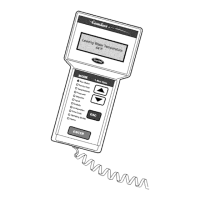
